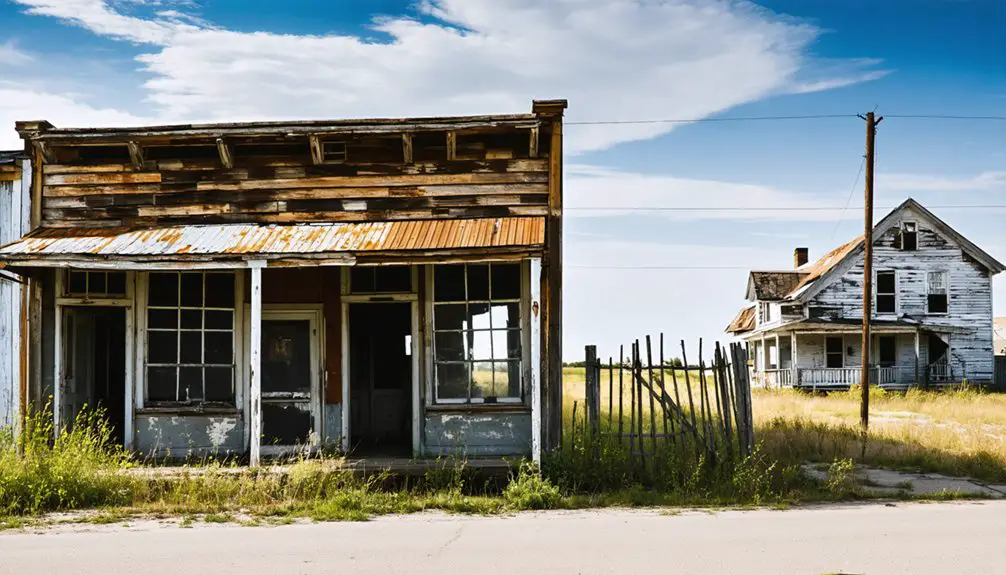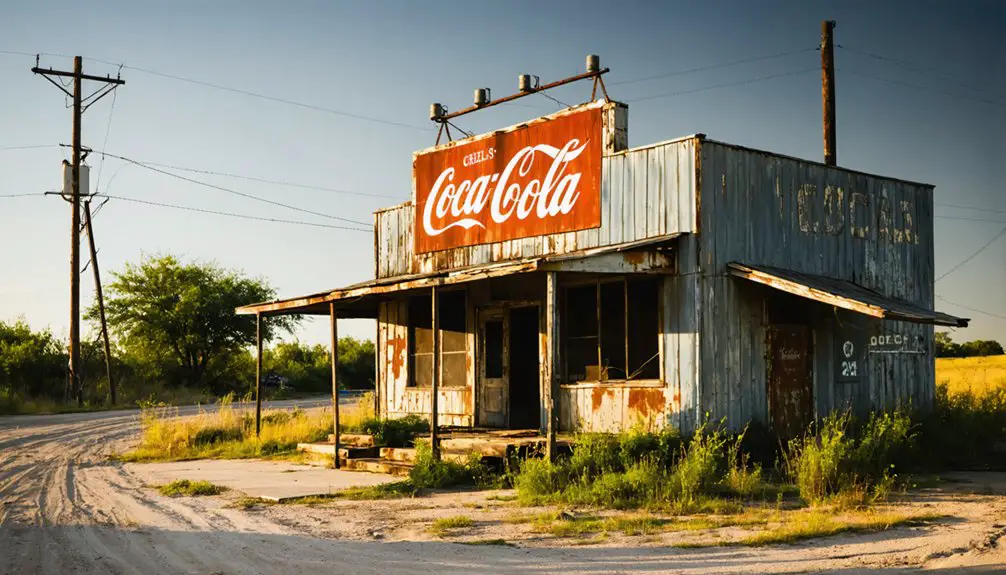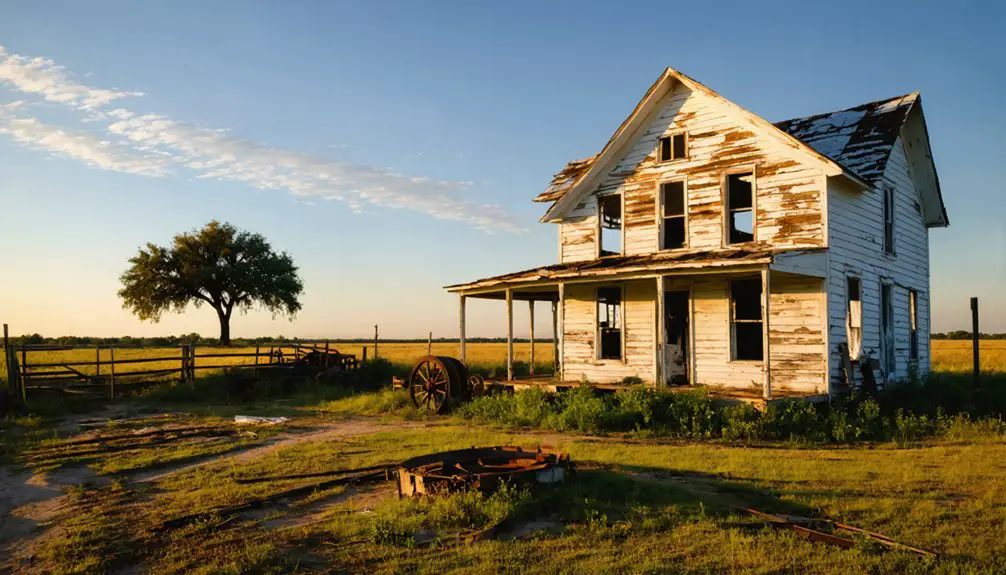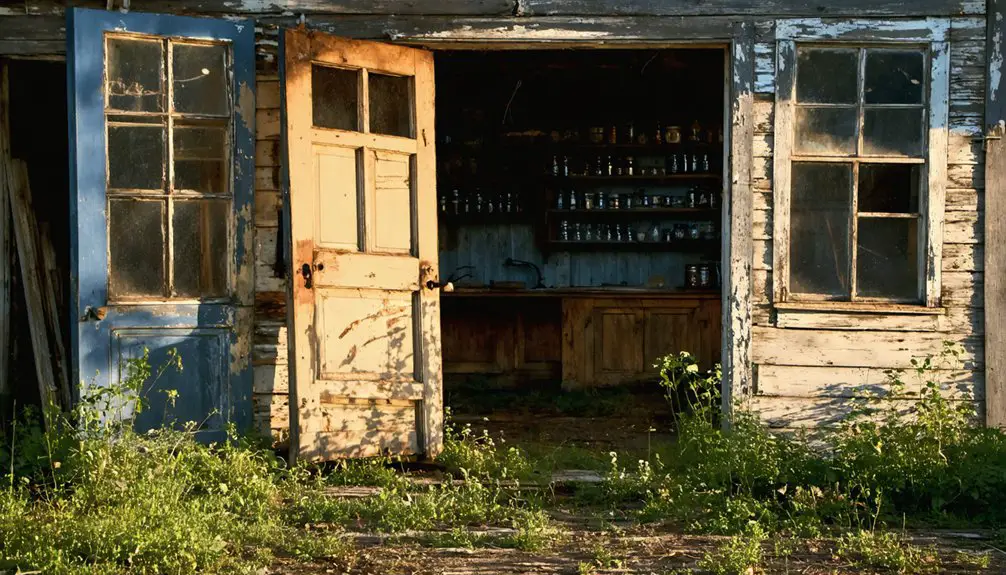You’ll find Coltharp nestled along Cochina Bayou in Houston County, Texas, where Eli Coltharp established a store and post office before 1860. As an essential stagecoach stop between Tyler and Crockett, the town flourished with a cotton gin, gristmill, and blacksmith shop. The historic Coltharp-Beall House, built in 1849, served as a rest station for travelers. When railroads bypassed the town, Coltharp’s decline began, leading to its ghost town status by the early 1900s. The site’s remaining structures tell a deeper story.
Key Takeaways
- Coltharp was founded before 1860 in Houston County as a stagecoach stop and trading post with a store and post office.
- The town flourished as a transportation hub with stagecoach services, cotton gin, gristmill, and blacksmith shop in the mid-1800s.
- The historic Coltharp-Beall House, built in 1849, served as a stagecoach rest station and represents the town’s architectural heritage.
- Railroad expansion bypassing Coltharp led to economic decline, resulting in post office closure by 1909 and school consolidation by 1925.
- Population decline, business closures, and agricultural mechanization transformed Coltharp from a thriving community into a ghost town.
Origins and Early Settlement
While many Texas settlements emerged along crucial waterways in the mid-1800s, Coltharp’s establishment before 1860 along Cochina Bayou marked the beginning of a lasting community in Houston County.
Coltharp’s settlement along Cochina Bayou in Houston County exemplifies the strategic growth of Texas communities near vital waterways.
The settlement patterns centered around Eli Coltharp, who founded the town’s first store and post office, establishing essential services for the growing population.
You’ll find the community origins deeply rooted in the strategic positioning along transportation routes, with the town serving as a crucial stagecoach stop.
The community quickly grew to include multiple commercial shops, including a gin, gristmill, blacksmith, and millinery establishments.
The Coltharp-Beall House, constructed in 1849, stands as one of the area’s earliest permanent structures, representing the architectural heritage of this frontier settlement.
Today, descendants of these pioneering families still call the surrounding area home, proof of the enduring legacy of those first settlers.
Much like the coal mining town of Thurber, the community maintained a system of armed company guards to regulate access and movement within its boundaries.
Life Along the Stagecoach Route
If you’d traveled through Coltharp in the mid-1800s, you would’ve found a bustling stagecoach stop where Sawyer, Risher & Hall’s lines connected travelers to Tyler and Crockett.
The Coltharp-Beall House served as a primary rest station where you could exchange mail, trade goods, and gather news from other settlements along the eastern Texas route. As with other routes throughout Texas, mail contracts provided stable funding that kept the stagecoach service operating.
Your visit would’ve revealed a frontier business hub where stage drivers, merchants, and local residents converged to maintain essential communication and commerce links in the developing Texas territory. Travelers paid a dime per mile for their journey, though rates could double during harsh weather conditions.
Early Traveler Rest Stops
As travelers journeyed across Texas in the mid-1800s, stagecoach stops emerged every 15-30 miles to provide essential services and respite.
You’d find varying levels of stagecoach amenities across the region – from refined hotels in East Texas to basic adobe structures in the western territories. The Coltharp-Beall House, built in 1849, served as a prime example of these crucial waypoints. Concord coaches were the preferred vehicles for these routes due to their reliable design. The routes operated by Sawyer & Risher dominated the Texas stagecoach landscape with extensive coverage from Hempstead to San Antonio.
Your traveler experiences would’ve included regular breaks for fresh horse teams, meals, and overnight lodging. Many stops, like the Hamburg stand, doubled as community gathering places where you could worship with traveling preachers.
These facilities weren’t just rest stops – they were lifelines supporting the logistics of westward expansion, providing mail handling, security from raids, and shelter from the elements during your arduous journey.
Mail and Trade Hub
Because mail delivery proved crucial to frontier development, Eli Coltharp’s establishment of a post office and store along the stagecoach route west of Nacogdoches in the late 1850s transformed the area into a significant communications hub.
The location served as a critical link for mail distribution and community connection, supporting the region’s growth through trade and information exchange.
You’ll find these important functions at Coltharp’s hub:
- Regular sorting and transfer of mail between larger cities
- Necessary supplies and goods for travelers and locals through the store
- Safe haven for stagecoach passengers requiring rest and provisions
- Trading post connecting isolated frontier settlements to broader markets
Despite risks from bandits and raids, Coltharp’s position along the stage route guaranteed its role in Texas’s expanding communication and commerce network. The establishment of Fort Mason in the area provided additional security for stagecoach travelers and mail carriers during this dangerous period.
Frontier Business Operations
Operating a stagecoach stop required extensive infrastructure and careful planning to serve both travelers and the surrounding community. You’d find facilities ranging from basic adobe structures to refined inns, spaced 15-30 miles apart to accommodate fresh horse teams and weary passengers.
These stops weren’t just rest areas – they functioned as crucial community hubs where locals gathered and worshipped. Coltharp served as a vital stop on the Dallas to Shreveport route.
Stagecoach operations demanded precise coordination of drivers, guards, and support staff to maintain strict twice-weekly schedules. Freight logistics involved managing mail contracts worth hundreds of thousands annually, while passenger fares provided additional revenue.
You’d see blacksmiths maintaining equipment, fresh horses ready for changeover, and armed guards preparing for the next dangerous stretch. Despite constant threats from bandits and raids, these frontier businesses persevered, connecting isolated communities to major trade centers.
The Rise of a Rural Trading Post
While settlers were establishing homesteads across Houston County in the 1850s, Coltharp emerged as an important trading post that would shape the region’s early commerce. Trading posts often relied on absolute authority over their local territories to effectively manage trade and protect settlers.
In the frontier days of 1850s Houston County, Coltharp trading post became a vital hub shaping the area’s economic destiny.
The trading post’s evolution from a simple store to a thriving hub of rural commerce began around 1857 with the establishment of its post office.
By 1891, three religious congregations had established churches to serve the growing community.
You’ll find the trading post’s rapid growth reflected in these key developments:
- Multiple mills processed cotton, lumber, and grain for local farmers
- Blacksmith and gunsmith shops provided essential equipment maintenance
- The post office facilitated critical communication networks
- Storage facilities and workspace supported regional distribution
The trading post’s strategic location on Cochino Bayou allowed it to serve as a collection point for goods, cementing its position as the economic backbone of the frontier community.
Community Development and Growth

You’ll find Coltharp’s initial settlement took shape before 1860, as pioneering families established an agricultural community in Houston County, Texas.
The town’s strategic position helped it develop into a modest trading hub, with local stores serving the everyday needs of farmers and ranchers.
Early Settlement Patterns
The early settlement of Coltharp, Texas began in the 1850s when pioneer Eli Coltharp established essential infrastructure along a stagecoach route near Cochina Bayou in Houston County. The settler demographics consisted primarily of Anglo-American farming families seeking new opportunities on the Texas frontier.
You’ll find that Coltharp’s early development was shaped by these key elements:
- Strategic location near water resources that supported agricultural practices
- Establishment of a store and post office as community focal points
- Connection to regional markets via stagecoach transportation routes
- Strong familial ties that maintained community continuity
The settlement’s growth patterns followed the natural landscape, with farms and homesteads dispersed along the bayou.
Families like the Coltharps anchored the community through generations, creating a stable but modest population base.
Trade and Postal Hub
As Coltharp evolved from a frontier settlement into a trade center in the late 1850s, Eli Coltharp’s establishment of a general store and post office along the stagecoach route marked a pivotal transformation.
The store’s trade connections extended beyond local farmers to travelers and merchants, while the post office’s significance grew as a crucial communication hub for Houston County.
You’ll find that Coltharp’s economic infrastructure expanded to include a cotton gin, gristmill, blacksmith shop, and millinery, creating a self-sustaining micro-economy.
The community’s role as a trade center was further strengthened by its Masonic lodge, combining commercial and social functions.
These developments positioned Coltharp as more than just a rural outpost – it became a multifunctional hub where you could process agricultural goods, receive mail, and engage in regional commerce.
Architectural Heritage and Landmarks
While many Texas ghost towns have succumbed to decay over time, Coltharp’s architectural heritage remains evident through its surviving structures and historic landmarks.
Local architectural styles showcase the town’s resourceful use of native stone and wood, adapted to withstand the semi-arid climate. Preservation efforts have focused on maintaining the town’s most significant structures.
You’ll discover these notable features:
- Standing masonry foundations that reveal late 19th-century construction techniques
- Historic commercial buildings with classic wooden storefronts and porches
- Tool sheds and antique machinery that illustrate the town’s industrial past
- Historical markers providing context for the remaining architectural elements
These surviving structures offer you a glimpse into Coltharp’s past as a thriving community, where architectural design met the practical needs of frontier life.
Economic Shifts and Population Changes

Beyond the physical structures that tell Coltharp’s story, economic forces shaped the town’s destiny through distinct phases of development and decline.
You’ll find that Coltharp’s alteration began with a thriving cotton and corn farming economy in the mid-1800s, supported by Eli Coltharp’s store and essential services like a cotton gin and gristmill.
The town’s fortunes shifted dramatically when the railroad bypassed it, triggering the first wave of population migration.
The economic decline accelerated after 1901 when a nearby sawmill drew residents away from farming.
By 1909, the post office closed, and the 1925 school consolidation with Kennard marked the community’s diminishing significance.
Like many East Texas towns, Coltharp’s fate was sealed by changing transportation routes and the shift from agriculture to timber-based industry.
The Path to Ghost Town Status
Through a series of cascading setbacks in transportation, economics, and demographics, Coltharp’s transformation into a ghost town unfolded systematically over several decades.
The town’s descent accelerated as transportation decline and economic stagnation took hold, creating a downward spiral that proved impossible to reverse.
Key factors that sealed Coltharp’s fate:
- Railroad expansion bypassed the town, eliminating its strategic position on stage routes.
- Young residents left for urban opportunities, depleting the community’s workforce.
- Agricultural mechanization reduced demand for local merchant services.
- Essential businesses closed as population dwindled, making the town unsustainable.
Without transportation access or economic drivers to sustain it, Coltharp couldn’t compete with better-positioned neighboring towns.
Buildings fell into disrepair, and the once-thriving community gradually faded into obscurity.
Historical Legacy and Documentation

Despite limited surviving structures, Coltharp’s historical legacy lives on through diverse documentation sources that paint a portrait of this 19th-century stage route settlement.
You’ll find the town’s story preserved in the Texas Ghost Town Newspapers collection at UNT Libraries, the Handbook of Texas, and Houston County records. These historical documentation sources reveal how Eli Coltharp’s store and post office served as essential links for travelers and settlers before 1860.
The cultural legacy of Coltharp reflects typical rural Texas life, preserved through oral histories and regional narratives.
You can explore the physical evidence at the town site, where ruins, cemetery plots, and historical markers validate its footprint. While archeological remains are minimal, they provide tangible connections to this once-thriving community hub.
Frequently Asked Questions
Are There Any Ghost Stories or Legends Associated With Coltharp?
As you wander the quiet bayou landscape, you’ll find no documented ghost sightings or local folklore specifically tied to Coltharp’s history, despite the town’s abandoned status and surviving historical structures.
What Natural Disasters or Events Impacted Coltharp’s Decline?
You won’t find evidence of flood damage or drought effects directly causing Coltharp’s decline. Instead, its fate was sealed by broader economic downturns and the general rural exodus in Texas.
Can Visitors Legally Explore the Remaining Structures in Coltharp Today?
Like fading footprints in desert sand, you can’t freely explore Coltharp’s structures today. Local regulations require explicit landowner permission, and without clear historical preservation status, legal access remains restricted for visitors.
Which Families Were the Last Residents to Leave Coltharp?
You won’t find definitive records of the last families who departed, as resident history isn’t well documented. While population declined to around 52 by 2000, specific names of final inhabitants remain unclear.
Are There Any Annual Events or Reunions Celebrating Coltharp’s History?
You won’t find any documented annual events or reunions celebrating Coltharp’s history. Unlike other Texas ghost towns that host regular gatherings, this remote location lacks organized commemorative events or festivals.
References
- https://texashighways.com/travel-news/four-texas-ghost-towns/
- https://www.youtube.com/watch?v=phjUE19A8HM
- https://en.wikipedia.org/wiki/List_of_ghost_towns_in_Texas
- https://www.hmdb.org/m.asp?m=29567
- https://texashistory.unt.edu/explore/collections/TGTN/
- https://www.tshaonline.org/handbook/entries/coltharp-tx
- https://www.tshaonline.org/handbook/entries/coltharp-beall-house
- https://www.texasescapes.com/EastTexasTowns/Coltharp-Texas.htm
- https://www.texasescapes.com/TOWNS/Texas-Ghost-Towns-6-East-Texas.htm
- https://www.texasalmanac.com/articles/butterfield-overland-mail-stagecoaching-in-texas



